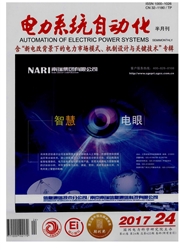

 中文摘要:
中文摘要:
针对统一电能质量调节器(UPQC)切换运行模式时引起的小扰动稳定性及动态交互影响问题,建立了包括串、并联变流器控制在内的小信号模型,对比分析了串、并联变流器独立运行以及联合运行时的稳定性及动态性能,并以特征根灵敏度的方法研究了控制参数、负荷等因素与UPQC运行模式切换时的小扰动稳定性的关联机理。该结论可为UPQC的参数设计提供部分参考依据,其后提出了可减少串并联变流器与电网之间能量交换、提高串联变流器利用率的新型功率流协调控制策略。时域仿真证实了相关结论的有效性及协调控制策略的可行性。
 英文摘要:
英文摘要:
A small signal stability model is developed based on the small-signal stability and dynamic interaction problems caused by operation mode-switching of unified power quality conditioners (UPQCs).The small-signal model also includes series and parallel converter controls.The stability and dynamic characteristics between independent converter operating mode and combined series and/or parallel converter operation mode are analyzed.Eigenvalue sensitivity analysis with respect to factors such as control-parameters and load-factors are also studied.This study can provide some theoretical guide for parametric design.A coordinated control strategy is also presented based on the new power flow compensation.Case studies are given to validate the effectiveness of the small signal stability model and feasibility of the proposed control strategy.
 同期刊论文项目
同期刊论文项目
 同项目期刊论文
同项目期刊论文
 期刊信息
期刊信息
